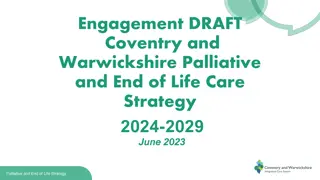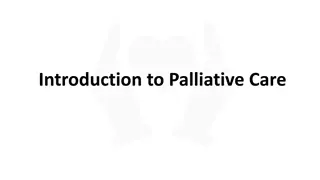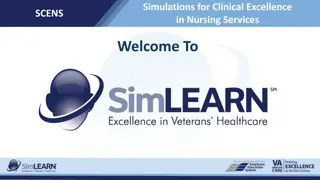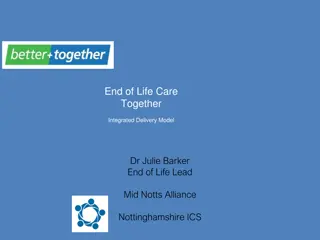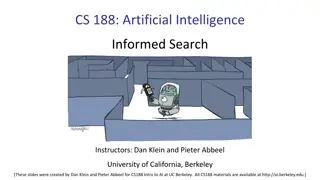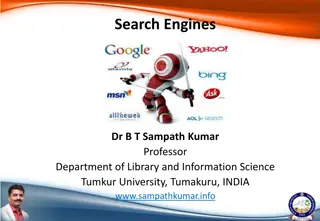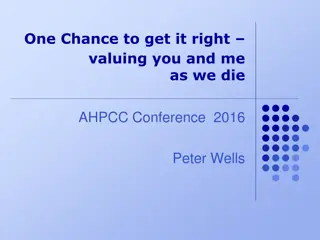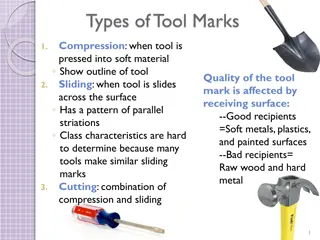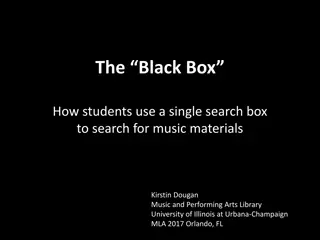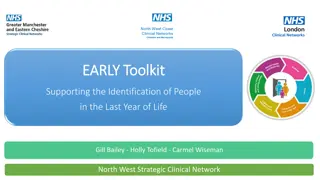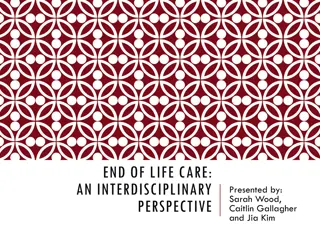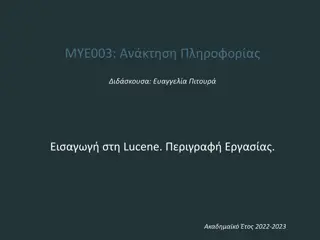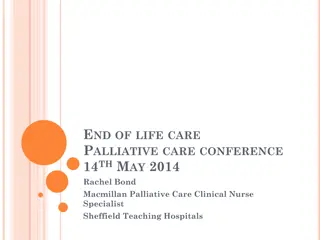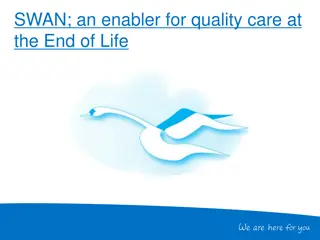Enhancing End-of-Life Care: The EARLY Identification Search Tool
The EARLY search tool is a valuable resource developed collaboratively to identify individuals in the last phase of life through SNOMED CT codes, enabling proactive care planning and better outcomes. The tool was tested in multiple GP practices and refined for implementation, aiming to improve care quality and reduce emergency admissions. Key stakeholders like NHS England and NHS Improvement supported the development and testing process.
Download Presentation

Please find below an Image/Link to download the presentation.
The content on the website is provided AS IS for your information and personal use only. It may not be sold, licensed, or shared on other websites without obtaining consent from the author. Download presentation by click this link. If you encounter any issues during the download, it is possible that the publisher has removed the file from their server.
E N D
Presentation Transcript
EARLY identification search tool and supporting resources Lyndsey Williams - Clinical Lead, EOLC Clinical Network NHSE/I (London Region) Nazmul Hussein EOLC Clinical Lead, Newham CCG Funmi Bisi-Adewole - Project Manager, EOLC Clinical Network NHSE/I (London Region) NHS England and NHS Improvement
WHAT is the EARLY search tool The tool searches SNOMED CT codes based on the Gold Standard Framework Proactive Identification Guidance (GSF PIG) and the Supportive and Palliative Care Indicators Tool (SPICT) resources and other key SNOMED CT codes identified through validation with over 50 GP Practices in the country Currently, the tool runs in both EMIS & SystmOne web GP IT system. What does EARLY stand for: Early identification Advance care planning Record Look again You can continually improve E A R L Y NHS England and NHS Improvement 2 | 2 |
WHY the EARLY search tool was developed A new quick Search Tool (EARLY) than is run within GP electronic patient records to identify those who may be in their last phase of life. Proactive and personalised care planning for everyone identified as being in their last year of life will enable a better quality of care, a reduction in avoidable emergency admissions and more people being able to die in a place they have chosen. NHS England and NHS Improvement 3 | 3 | Presentation title
HOW the EARLY search tool was developed Collaboratively with Great Manchester and Eastern Cheshire and the North West Coast Strategic Clinical Network, the Newham CCG EOLC Clinical lead and the NHSE/I London EOLC CN The EARLY project tested the clinical search tool within several GP practices across Greater Manchester, Lancashire, South Cumbria, Cheshire, Merseyside and North East London to determine whether the clinical codes used in the search tool identified patients appropriately. The testing period ran from April- June 2019 and enabled the clinical search tool to be refined ready for pilot within 78 practices across 3 areas in the North West of England - Lancashire & South Cumbria, Cheshire & Merseyside and Greater Manchester and in 3 Newham GP Practices from August 2019 February 2020 . The Newham project also tested the clinical pathways along with the search tool. The aim of the further testing was to determine through General Practice How user friendly the clinical search tool was? How helpful the tool was in identifying patients appropriately? Whether the clinical search tool needed further refinement? NHS England and NHS Improvement 4 | 4 | Presentation title
Key outcomes of the Midlands Identification Project Areas Greater Manchest er Cheshire & Merseysid e 21 Lancashir e & South Cumbria Total All GP practices using EMIS found the clinical search tool easy to run. Using the EARLY clinical search tool can be used to improve the spread of morbidity on supportive care registers potentially improving the care for patients with organ failure and frailty/dementia at the end of life, promoting equity. 14 17 Number of Practices per area 52 534 706 450 Number of patients search tool identified & added to end of life care register 1690 Having an identified GP within the practice with dedicated time provides clinical leadership and supports the implementation of the EARLY tool. The clinical search tool can be applied through the administrative team but time by a GP to clinically validate the patient for inclusion on the supportive care register is needed. Total Patient Population - 482,395 133% increase in completed personalised care plans NHS England and NHS Improvement 5 | 5 | Presentation title
Key outcomes of the Newham Identification Project Practice A B C Total The number of staff with a CMC log in across the three GP practices increased from 5 staff to 79 staff. The total number of electronic CMC care plans created has increased from 20 care plans to 72 During the project cohort, 6 patients with a care plan died, 5 of those patients died in their preferred place of death. Total views by urgent care services (LAS, A & E, 111) was 3 views before the project compared to 155 views afterwards. 13921 8500 19552 41981 List Size 27 128 Number of patients search tool identified 28 73 (14M, 13F) (0.3% of list size) (15M 13 F) (33 F, 40 M) Number of appropriately identified patients 18 19 62 99 (77% of those the tool identified) Number of CMC plans completed 13 11 48 72 (78% of those offered) NHS England and NHS Improvement 6 | 6 | Presentation title
Benefits Increase those identified and included in your palliative and supportive care register Increase the proportion patients offered personalised care and support plans Increase CMC care plans created Increase potential for the people under your care achieving their wishes and preferences at the end of life Build on the EOL QOF QI module 19/20 to enhance the quality of end of life care Support achieving the GP PCN Care home DES 20/21 Support achieving GP PCN Personalised and Anticipatory Care DES 21/22 The pilot has helped the whole team to be more aware of spotting patients at the end of life and starting discussions and using CMC more productively . - GP It is easy to upload on EMIS and runs seamlessly - Assistant Practice Manager. Good idea, will encourage other people to have a care plan - Patient NHS England and NHS Improvement 7 | 7 |
EARLY identification toolkit Interactive PDF Supporting a 5 step approach: 1) Identification run the search tool 2) Clinical review 3) Personalised care and support Planning 4) Sharing Information (CMC) 5) Review and revisiting NHS England and NHS Improvement 8 | 8 | Presentation title
Early Identification EMIS search City & Hackney NHS England and NHS Improvement 9 | 9 | Presentation title
Lessons Learnt from Newham Project Key lessons learnt for GP practices: It was assumed practices regularly reviewed and updated their palliative care register including advance care plans and recording these onto CMC; however, this was not the case. The majority of practices palliative care registers were only for patients known to specialist palliative care and did not have a care plan that was shared on CMC. CMC data validation: The participating GP practices found this exercise very useful- all draft plans were reviewed, approved, completed and published and GPs felt more confident with using the CMC digital platform. Using the wider workforce to support capacity in primary care - e.g EOLC champions, pharmacists and social prescribers are recommended. The word end of life was felt to be inappropriate to some patients / relatives. Individual patients situation/circumstances need to be considered along with their cultural and religious beliefs when engaging in personalised care planning discussions. Some of the phrases practices found useful were: there is a need to co-create a care plan so that all healthcare staff looking after you (patient) can view it or we are calling you to discuss your care, what is important to you and how we can share your wishes with other professionals . NHS England and NHS Improvement 10 | 10 | Presentation title
Lessons Learnt from Newham Project Contd Lessons learnt for the wider system : People who have been appropriately identified as frail after using eFrailty index need to be coded appropriately into GP IT systems so that the EARLY search tool is able pick these patients up. There is no EMIS READ code for actual cause of death and this information is not routinely recorded, making reporting difficult. Personalised care plans for all over 80 or 85 years to be considered. Most of the personalised care planning discussions were GP driven; a greater involvement of multidisciplinary team members in early identification and support of patients and families as they approach the last phase of their life will be beneficial. Continual effort is needed to ensure personalised care planning discussions are shared with and viewed by relevant services. Increase public awareness by advertising personalised care planning and CMC in public settings e.g. GP practice reception areas, libraries, pharmacies. NHS England and NHS Improvement 11 | 11 | Presentation title
Top Tips Involve every practice staff from the start and appoint a lead or EOLC/EARLY Champion. Education and training on communication skills, holding compassionate (difficult) conversations and personalised care planning was very beneficial for primary care staff. Using the CMC template was really helpful to use as a checklist of things to ask patients. It is vital to have a comprehensive EOLC Directory of Community services to be able to signpost patients to information and local support services. Making every contact count - one of the participating GPs completed most of the personalised care planning discussions whilst on home visits for flu vaccinations. Not one size fits all- customise engagement to individual patients & carers (physical, emotional, cultural and spiritual needs). Other important tips, if considering a project: It takes time to build relationships with stakeholders factor this into projects. By providing ongoing background support to the participating practices by the project team, staff showed great proactiveness leading to some unexpected benefits. Constantly review project goals and stakeholders list to ensure relevance. NHS England and NHS Improvement 12 | 12 | Presentation title
Newham Identification Project - Case Study Patient was identified by the new search tool who was not already on the GP s end of life care register They were offered and completed a personalised care plan discussion which was documented onto CMC The patient died at her preferred place of death during the 6-month Newham project The death was on a weekend The family contacted the paramedic s and because the patient had not been seen in the last 14 days by his GP, the police were called and patient was referred to the coroner The family contacted the patient s GP first thing on Monday morning The GP contacted the coroner and explained there was a CMC care plan and DNAR in place and that this was an expected death. It was agreed a post-mortem was not required in this case. By having an early personalised care discussion and a CMC care plan in place, the patient and family did not have to go through a coroner s review and post-mortem. NHS England and NHS Improvement 13 | 13 | Presentation title
Toolkit is now live https://future.nhs.uk/EOLC_Practitioners/view?objectId=80956 965 For Access email : sherree.fagge@nhs.net NHS England and NHS Improvement 14 | 14 | Presentation title



